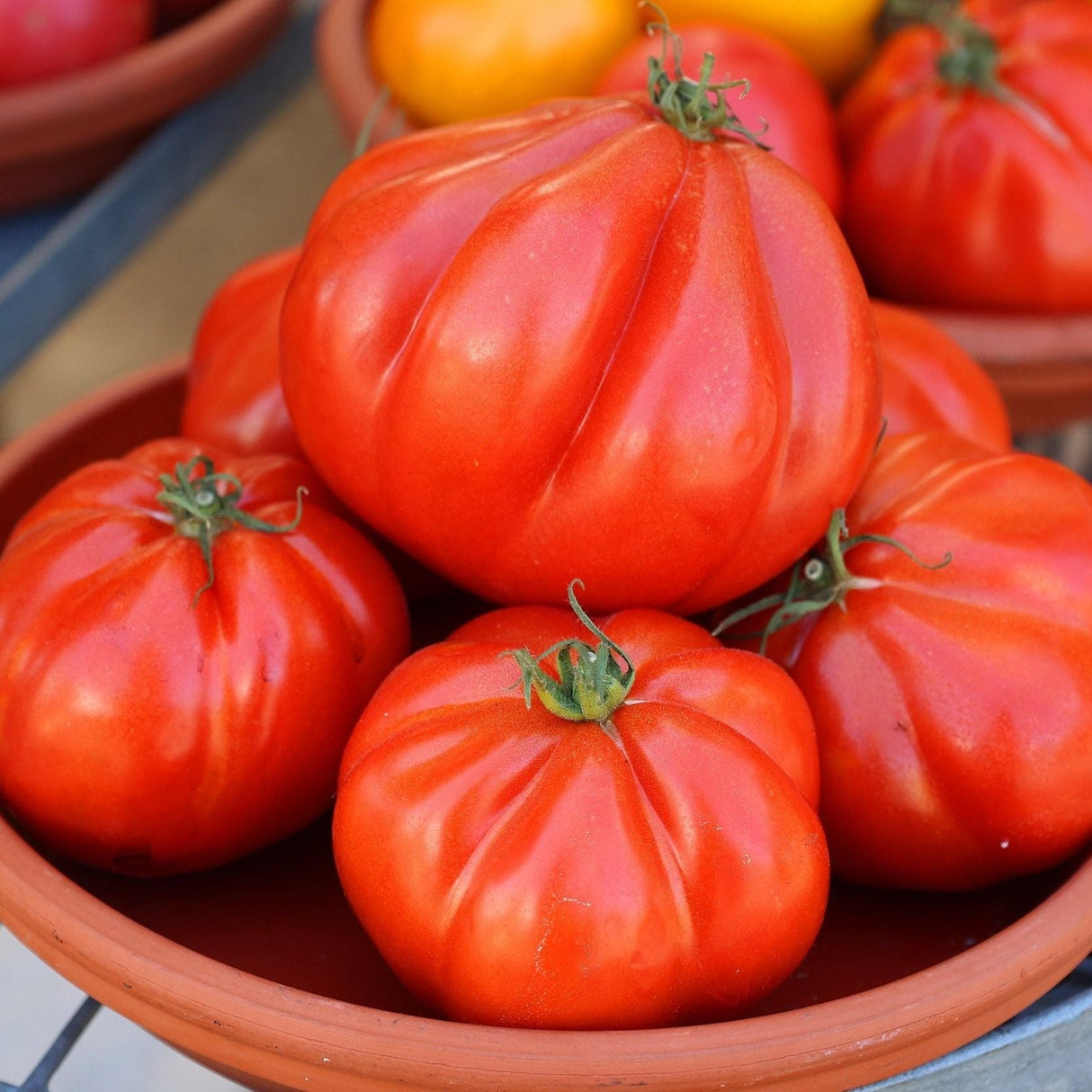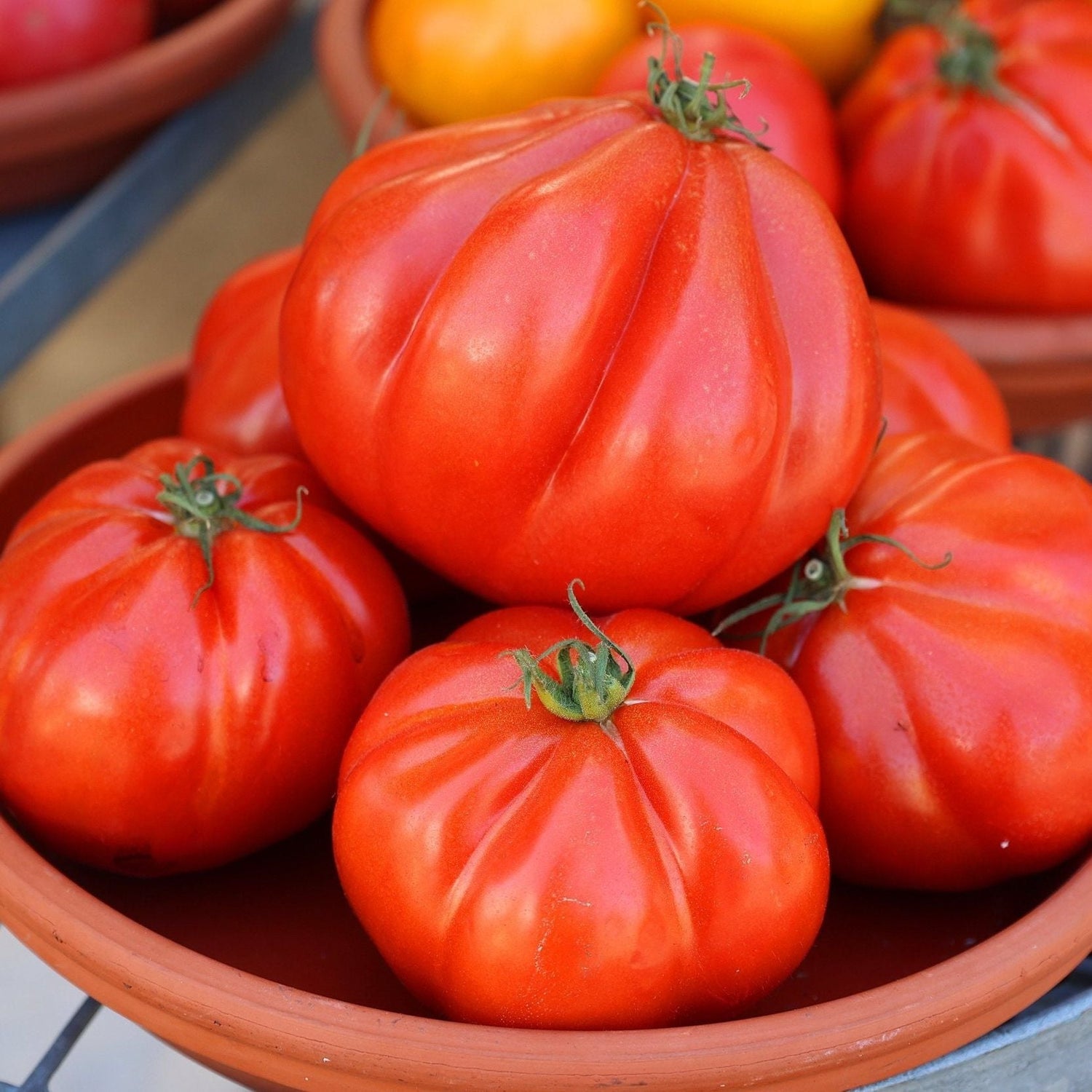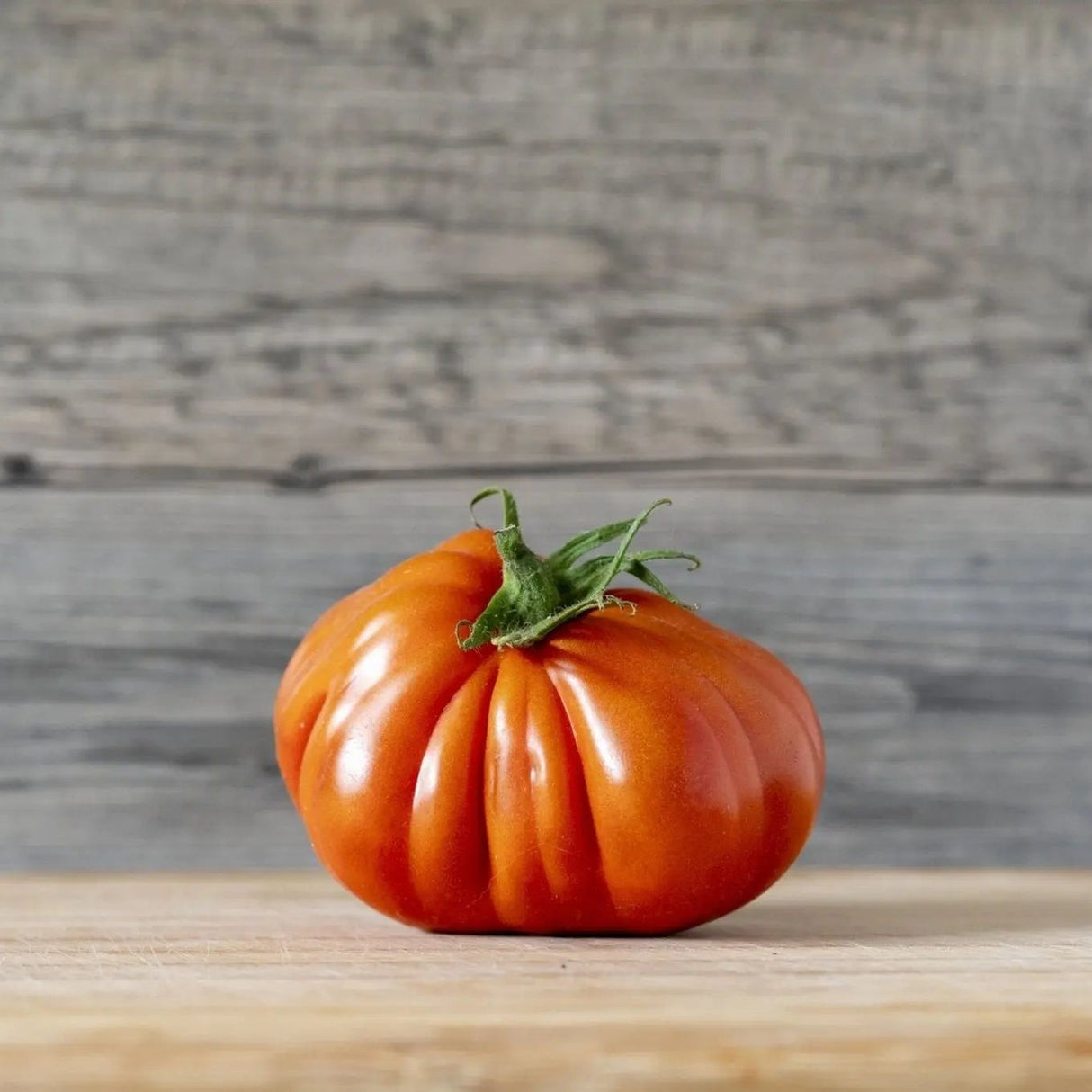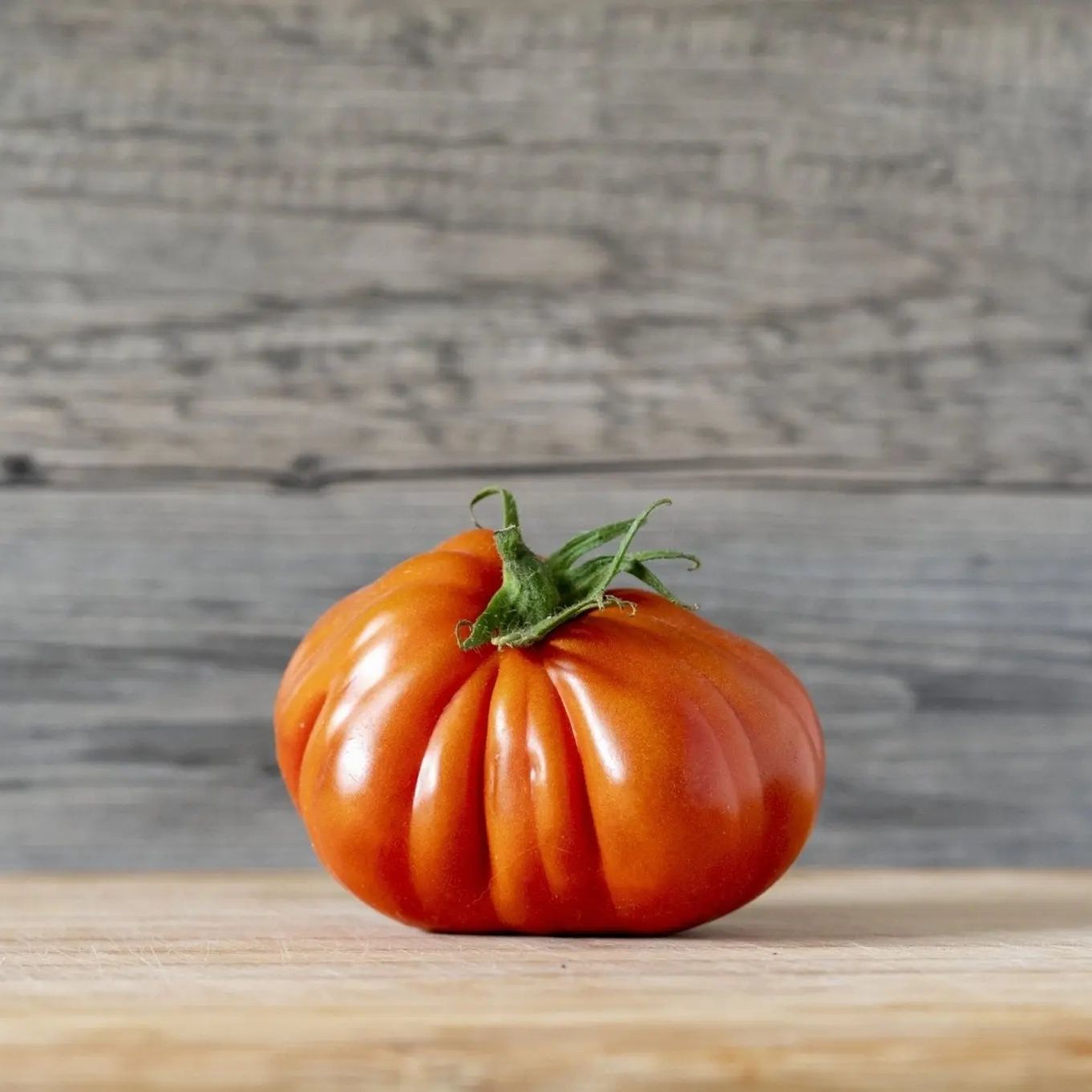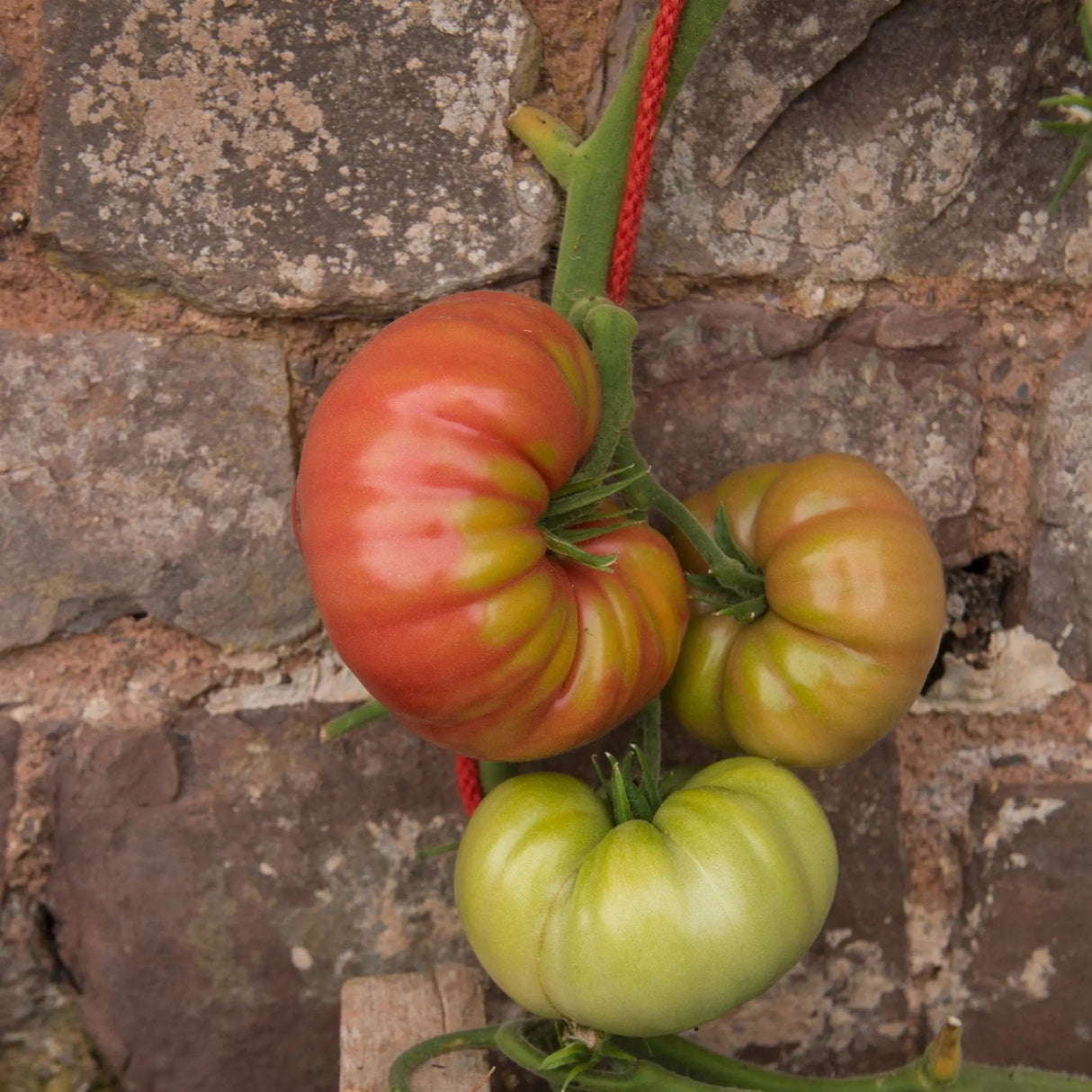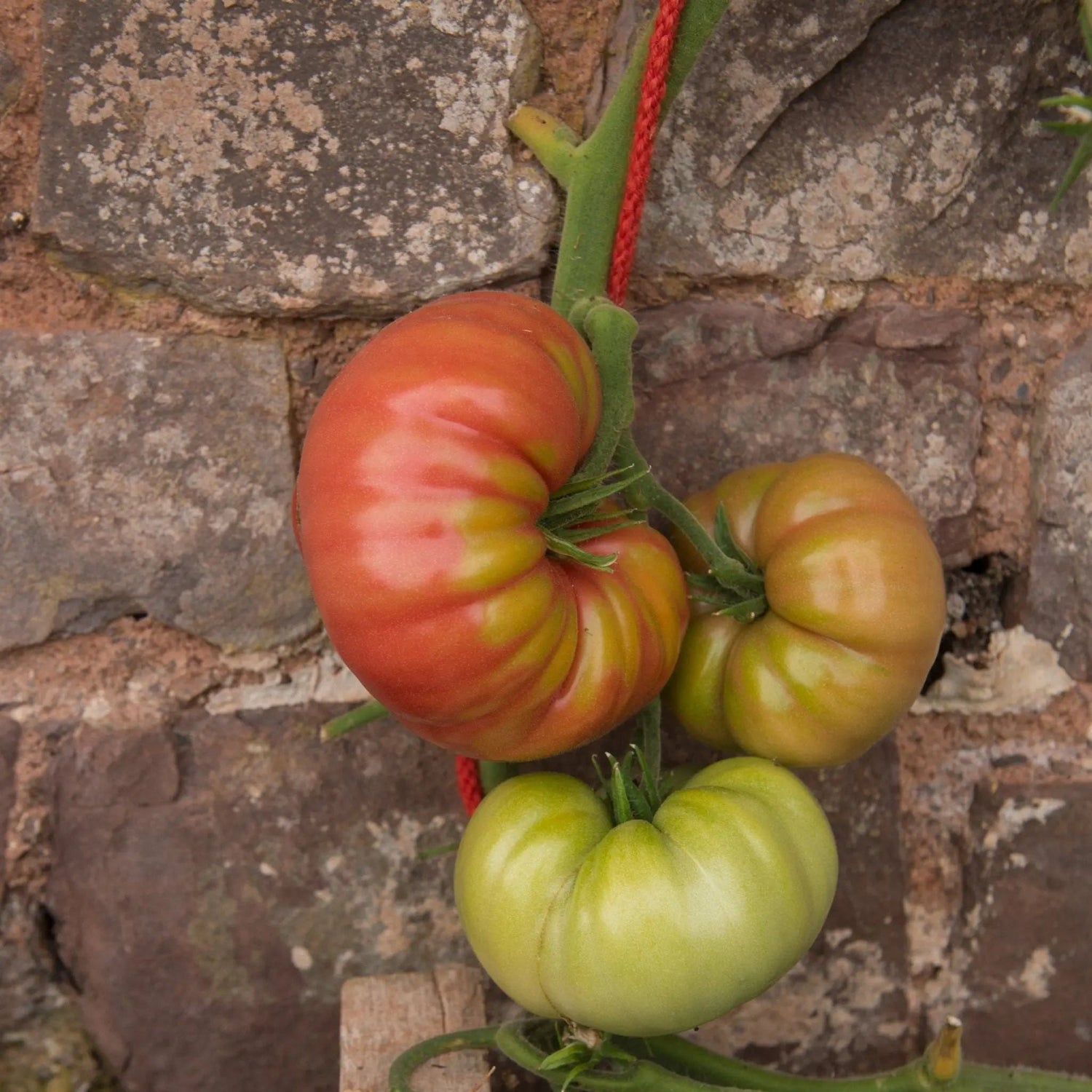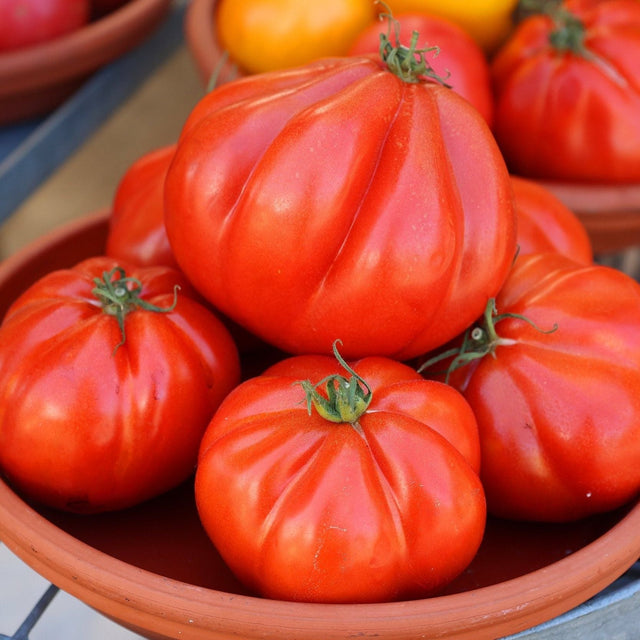Tomato Seeds - Indeterminate - Mortgage Lifter Beefsteak
Massive, pink, meaty tomatoes born from Depression-era ingenuity.
- Non-GMO Safe Seed Pledge
- Seed packets printed on forestry-certified paper (FSC, SFI, Rainforest Alliance)
- Curbside-recyclable mailers; SFI-certified kraft paper
- 1% for the Planet partner — supports environmental nonprofits
- Compact, energy-efficient facility with lean, low-waste operations
- Seeds: When properly stored, planted, and cared for, we guarantee reasonable germination and true-to-type growth for one year from purchase.
- Non-seed products: Free from defects in materials and workmanship for 30 days from shipment.
Excludes factors outside our control (extreme weather, pests, gardener error). If something’s off, contact us—we’ll make it right with a replacement, repair, or refund.
We do not sell seeds that are GMO or BE.
USDA “bioengineered (BE)” foods are those with detectable genetic material that was modified using in vitro recombinant DNA (rDNA) techniques, in ways not obtainable through conventional breeding or found in nature. The USDA’s National Bioengineered Food Disclosure Standard uses “bioengineered” as the nationwide labeling term.
- Detectable modified genetic material in the final food
- Created via in vitro rDNA techniques (e.g., gene transfer)
- Modifications not achievable through conventional breeding or nature
Description
The Mortgage Lifter Tomato is a legendary American heirloom bred in the 1930s by Radiator Charlie Byles, who famously sold enough of these plants to pay off his mortgage—hence its name. This indeterminate variety produces huge, 1–2 pound fruits with a rich pink-red color, meaty texture, and minimal seeds, making it ideal for slicing and sandwiches.
Maturing in about 80–85 days, the fruit offers a deep, old-fashioned tomato flavor—balanced between sweetness and acidity with a dense, juicy flesh that holds up in salads, sauces, and canning. Its size and reliability have made it a mainstay among heirloom growers and market gardeners for nearly a century.
Plants are vigorous and heavy-bearing, growing 6–8 feet tall with strong stems that benefit from sturdy staking or caging. They thrive in full sun and nutrient-rich, well-drained soil, producing consistently even in long, hot summers. The Mortgage Lifter remains a testament to classic seed stewardship and the power of one gardener’s dedication to quality and flavor.
Your payment is processed securely via trusted gateways. We do not store credit card details and we do not have access to your card information.
Couldn't load pickup availability
1. Choosing the Right Location
Light Requirements:
Tomatoes are sun-loving plants that require at least 6–8 hours of direct sunlight daily, though 8–10 hours is ideal for strong fruit set and flavor. Choose a site with full southern exposure whenever possible. Avoid shaded areas near trees, fences, or tall crops. Plants grown in partial sun may produce leggy growth and fewer fruits.
Soil Requirements:
Tomatoes thrive in well-drained, loamy soil enriched with organic matter. The optimal pH range is 6.0–6.8, though they tolerate slightly acidic conditions. Prepare beds ahead of time by incorporating aged compost, leaf mold, or well-rotted manure to improve structure, fertility, and microbial activity.
Avoid compacted or waterlogged soil, which restricts root growth.
Sandy soils warm faster and suit early crops; heavier soils retain moisture better in dry climates.
Rotate planting sites annually to prevent nutrient depletion and disease buildup.
Soil Preparation Tip:
Before sowing or transplanting, loosen the top 8–12 inches of soil and blend in 2–3 inches of organic compost. If needed, amend with bone meal for phosphorus and greensand or kelp meal for potassium to promote strong roots and flowering.
2. Starting Seeds Indoors
Timing:
Sow tomato seeds 6–8 weeks before the final expected frost date. Adjust timing to your region so that transplants are ready to go outside once the soil has warmed to at least 60°F (16°C) and nighttime temperatures remain above 50°F (10°C).
Containers and Medium:
Use clean trays or small pots filled with a sterile, fine-textured seed-starting mix. Avoid heavy garden soil, which compacts easily and harbors pathogens.
Sowing Depth:
Sow seeds ¼ inch deep, cover lightly, and mist gently to settle the soil. Maintain even moisture—damp but never soggy.
Germination Conditions:
Tomato seeds germinate best at 75–85°F (24–29°C). Use a heat mat if needed. Germination typically occurs within 5–10 days, though some heirloom varieties may take up to two weeks.
Light After Germination:
Once sprouts appear, move trays to a bright, warm location or under full-spectrum grow lights. Provide 14–16 hours of light per day to prevent leggy growth. Keep lights about 2–3 inches above the seedlings and raise them as plants grow.
3. Transplanting Seedlings
Thinning:
Once seedlings develop their first set of true leaves, thin weaker ones to ensure each has ample light and airflow. Handle gently by the leaves, not the stems.
Potting Up:
When seedlings reach 3–4 inches tall, transplant them into larger pots (3–4 inches wide). Bury the stems up to the first true leaves—tomatoes form new roots along buried stems, creating stronger plants.
Hardening Off:
7–10 days before transplanting outdoors, gradually acclimate plants to outdoor conditions:
Start with 1–2 hours of filtered sun the first day.
Increase exposure each day, reducing watering slightly to toughen the stems.
Avoid windy or cold days during hardening.
4. Planting Outdoors
Timing:
Transplant tomatoes after the danger of frost has passed and the soil is warm. Soil temperatures below 55°F (13°C) can stunt root growth. Early planting can be improved by warming the soil with black plastic or row covers two weeks prior to transplanting.
Planting Depth:
Plant deeply—bury the stem up to the first or second set of true leaves. This encourages a robust root system. In heavy clay soil, plant slightly shallower and mound soil around the base.
Spacing:
Determinate (bush) types: 18–24 inches apart
Indeterminate (vining) types: 24–36 inches apart
Rows: Space rows 30–42 inches apart for good airflow and access.
Proper spacing reduces humidity around leaves, helping prevent fungal disease and promoting even ripening.
Watering at Planting:
Water thoroughly after transplanting to settle soil around the roots. Use lukewarm, non-chlorinated water. Avoid overhead watering—direct it at the base to minimize leaf wetness and disease spread.
5. Watering and Moisture Management
Initial Watering:
Keep the soil evenly moist but never waterlogged during germination and early growth. Light, frequent watering helps young roots establish.
Ongoing Watering:
Once established, switch to deep, infrequent watering, encouraging roots to grow downward. Aim for about 1–1.5 inches of water per week, adjusting for weather and soil type. Water early in the day so foliage dries before evening.
Organic Tip:
Use rainwater whenever possible—its natural minerals and softness encourage better plant health compared to chlorinated tap water.
6. Temperature and Climate Conditions
Tomatoes favor warm conditions with daytime temperatures between 70–85°F (21–29°C) and nighttime temperatures above 55°F (13°C). Extended cold slows growth, while prolonged heat above 95°F (35°C) may reduce fruit set.
In hot climates, provide light afternoon shade using shade cloth or tall companion crops (basil, corn, or sunflowers). In cooler regions, use row covers or cloches to retain warmth during early growth. Maintain steady soil warmth for optimal root activity.
7. Fertility and Soil Feeding
Before planting, mix compost into the soil at a rate of about 1 part compost to 3 parts native soil. Tomatoes are moderate-to-heavy feeders but respond best to slow, balanced nutrition.
At planting time: mix a small handful of organic tomato fertilizer, bone meal, or worm castings into the hole.
Mid-season: side-dress with compost or dilute fish emulsion every 3–4 weeks.
Avoid over-fertilizing with nitrogen, which produces lush foliage but few fruits.
8. Early Support and Spacing Care
Install stakes, cages, or trellises at planting to avoid root disturbance later. Even determinate types benefit from light support to prevent fruit from touching the soil.
Maintain generous spacing to improve air circulation and light penetration—critical for disease prevention and even ripening.
9. Mulching and Moisture Control
After transplanting, apply 2–3 inches of organic mulch (straw, shredded leaves, or composted bark) around the base of each plant. Leave a small gap around the stem to prevent rot.
Mulch helps:
Retain soil moisture
Regulate temperature
Suppress weeds
Prevent soil from splashing onto leaves (reducing blight risk)
Refresh mulch as it decomposes throughout the season.
10. Organic Pest and Disease Prevention at Planting
Healthy soil and spacing are your best defense. Avoid synthetic chemicals—rely on prevention and natural balance.
Pests: Keep an eye out for aphids, hornworms, and whiteflies. Use neem oil, insecticidal soap, or hand-picking to control populations early.
Disease Prevention:
Water at the base to avoid wet leaves.
Provide good air flow between plants.
Rotate crops yearly; avoid planting tomatoes after peppers, potatoes, or eggplants.
Use compost teas (aerated or non-aerated) as a soil drench to boost microbial health.
Companion plants like basil, marigold, garlic, and borage help deter pests naturally while enhancing pollination and flavor.Choosing the Right Location:
Light Requirements: Tomato - Yellow Pear thrives in full sun. Select a location that receives at least 6-8 hours of direct sunlight daily.
Soil Requirements: Prefers well-drained, fertile soil with a pH of 6.0-6.8. Although adaptable to various soil types, it grows best in loamy soil enriched with organic matter.
Planting Seeds:
Timing: Start seeds indoors 6-8 weeks before the last expected frost date. Transplant seedlings outdoors after the last frost when the soil has warmed.
Sowing Depth: Sow seeds 1/4 inch deep in seed-starting mix. Cover lightly with soil and water gently.
Spacing: Thin seedlings to 18-24 inches apart when transplanting to allow adequate space for growth. Rows should be spaced about 24-36 inches apart.
Watering:
Initial Watering: Keep the soil consistently moist but not waterlogged until the seeds germinate, which typically takes 7-14 days.
Ongoing Watering: Once established, water deeply and regularly, especially during dry periods. Water the plants at the base to avoid wetting the foliage, which can lead to fungal diseases.
Temperature and Climate:
Preferred Temperature: Tomato - Yellow Pear grows best in warm temperatures ranging from 70-85°F (21-29°C). It can tolerate higher temperatures but may require more frequent watering during extreme heat.
Fertilization:
Feeding: Incorporate organic matter such as compost into the soil before planting. Use a balanced, all-purpose fertilizer at planting time and side-dress with compost or organic fertilizer mid-season.
Pruning and Thinning:
Thinning: Thin seedlings to prevent overcrowding, which can hinder growth and reduce air circulation.
Pruning: Prune suckers (the small shoots that grow between the stem and branches) to promote larger fruit production. Stake or cage plants to support the vines and improve air circulation.
Mulching:
Mulch Application: Apply a layer of organic mulch around the base of the plants to retain soil moisture, suppress weeds, and regulate soil temperature. Avoid piling mulch directly against the stems to prevent rot.
Pest and Disease Management:
Common Pests: While tomatoes can attract pests such as aphids, tomato hornworms, and whiteflies, using insecticidal soap or neem oil can help control these pests if necessary.
Diseases: Ensure good air circulation around the plants to prevent fungal diseases. Avoid overhead watering to minimize the risk of mildew and other fungal issues. Crop rotation and proper spacing can also help reduce disease incidence.
Watering
Provide 1–1½ inches of water weekly, increasing slightly during dry or fruit-heavy periods.
Water deeply and evenly to encourage strong roots and prevent cracking.
Use drip irrigation or soaker hoses for consistent moisture at soil level while keeping foliage dry.
Avoid overhead watering, especially late in the day, to minimize fungal disease.
Mulch 2–3 inches deep with straw, compost, or shredded leaves once soil warms to stabilize temperature and moisture.
Tip: Steady watering keeps Mortgage Lifter’s giant fruits smooth and firm—fluctuations cause cracking and uneven ripening.
Fertilizing
Before planting, work 2–3 inches of compost or aged manure into the soil.
Feed every 2–3 weeks with a balanced organic fertilizer (10-10-10 or equivalent) during early growth.
Once flowering begins, switch to a low-nitrogen, high-potassium blend (5-10-10) to promote large, flavorful fruit development.
Supplement with calcium or kelp extract monthly to prevent blossom end rot and strengthen stems.
Avoid overfertilizing—excess nitrogen encourages heavy foliage and poor fruit set.
Tip: A light midseason application of compost tea or seaweed extract helps sustain heavy fruit loads through peak summer.
Weeding & Mulching
Keep the area around plants weed-free to reduce competition and pest harborage.
Apply 2–4 inches of organic mulch—straw, compost, or shredded leaves—to conserve moisture and suppress weeds.
When weeding, loosen soil gently near the plant base to avoid root disturbance.
Sun & Heat Management
Provide full sunlight—6–8 hours daily ensures full coloration and maximum sweetness.
Ideal air temperature range: 75–90°F (24–32°C).
In extreme heat (above 95°F or 35°C), use 30–40% shade cloth to prevent flower drop and fruit scald.
Maintain adequate airflow between plants to minimize humidity and prevent fungal issues.
Tip: Mortgage Lifter thrives in warmth but prefers steady temperatures—avoid extremes for the best yields.
Spacing & Support
Space plants 30–36 inches apart with 36–48 inches between rows.
Being an indeterminate beefsteak, this variety requires sturdy cages, trellises, or stakes to support heavy fruit clusters.
Train vines vertically to promote airflow and ease of harvest.
Remove lower leaves beneath the first flower cluster to reduce disease risk.
Tip: Heavy fruits may need sling supports or soft ties beneath clusters to prevent stem breakage.
Companion Planting
Good Companions: Basil, marigolds, onions, garlic, parsley, and carrots deter pests and enhance pollination.
Avoid: Fennel, corn, and brassicas that compete for nutrients or harbor pests.
Interplant with dill, coriander, or thyme to attract beneficial insects and pollinators.
Tip: Basil planted near Mortgage Lifter not only repels pests but also enhances flavor naturally.
Container Growing
Grow in extra-large containers (minimum 25 gallons) with a heavy-duty trellis or cage.
Use rich organic potting soil blended with compost and perlite for structure and drainage.
Check moisture daily—large plants draw water quickly.
Feed every 10–14 days with compost tea or a liquid tomato fertilizer for steady nutrition.
Tip: Container-grown plants produce fewer but earlier fruits—maintain consistent watering to avoid stress cracks.
Season Extension
Use row covers or low tunnels early in the season to protect transplants from cool nights.
Preheat soil with black plastic mulch before transplanting in cooler climates.
Remove new blossoms about 4 weeks before the first frost to direct energy toward ripening existing fruit.
Harvest nearly ripe fruits before frost—they will finish ripening indoors at 65–70°F (18–21°C).
Tip: Mortgage Lifter fruits continue ripening beautifully off the vine—store them stem-side down in a single layer for best results.
Harvesting:
Harvest when fruits reach full rosy-red coloration with slightly pink undertones and smooth, heavy shoulders. Mature fruits typically weigh 16–32 ounces, with some exceeding two pounds under optimal conditions. The skin should feel firm yet slightly yielding when pressed near the stem.
Use pruning shears or scissors to harvest cleanly, leaving a short stem section attached to prevent tearing. Avoid twisting fruit off the vine, as the stems are thick and can damage the calyx.
Pick every two to three days during ripening to prevent overripe fruit from cracking or splitting under its own weight. Avoid harvesting directly after rain or watering — high moisture can cause shoulder cracking. Slightly underripe fruits will ripen evenly indoors at 68–72°F (20–22°C), retaining their full sweetness and texture.
Flavor & Culinary Use:
Mortgage Lifter is famous for its rich, old-fashioned tomato flavor — meaty, sweet, and mildly tangy with deep, satisfying umami. Its dense texture and small seed cavities make it one of the most flavorful and substantial beefsteaks ever bred.
Perfect for thick slicing on sandwiches, burgers, and caprese salads. When cooked, the flesh softens into a velvety sauce base with a natural sweetness that needs little added sugar.
This variety’s balanced acidity also makes it ideal for canning and slow-simmered sauces, where it retains both texture and color. Its flavor deepens beautifully when roasted, developing a caramel-like richness that pairs well with herbs and roasted garlic.
Handling & Storage:
Store harvested fruits at 55–70°F (13–21°C) in a cool, dry, and well-ventilated area. Avoid refrigeration, which dulls sweetness and causes mealy texture.
Because of the large fruit size and thin skin, handle gently to prevent bruising. Place fruits in a single layer, stem-side down, on padded or paper-lined trays. Avoid stacking or overcrowding.
Harvest slightly before full ripeness for market or transport to reduce cracking and extend shelf life. When properly handled, Mortgage Lifter tomatoes retain prime flavor and texture for up to a week.
Pruning & Support:
As an indeterminate, vigorous grower, Mortgage Lifter requires heavy-duty support and consistent pruning. Provide sturdy trellises, cages, or stakes at least 7–8 feet high to support its long vines and heavy fruit clusters.
Remove lower leaves after the plant establishes to improve airflow and reduce soil-borne disease risk. Pinch small suckers below the first flower cluster to channel energy into primary stems and larger fruit.
Avoid excessive pruning, as foliage helps shade the large fruit and prevents sunscald. Tie or clip clusters as they develop — mature fruits can strain stems if unsupported.
Sun & Water Tips:
Provide 6–8 hours of direct sunlight daily for rich color and maximum sugar accumulation. In high-heat climates, light afternoon shade helps prevent cracking and softening.
Maintain consistent soil moisture through deep watering once or twice weekly. Irregular watering during ripening can cause cracking or blossom-end rot.
Apply mulch (straw, compost, or shredded leaves) once soil warms to retain moisture, stabilize temperature, and suppress weeds.
Use drip irrigation or soaker hoses to water at the root zone while keeping leaves dry, reducing risk of foliar diseases like blight and septoria leaf spot.
Seed Saving:
Select seed from healthy, true-to-type plants bearing large, uniform pink-red fruits with balanced sweetness. Allow chosen fruits to ripen fully on the vine for mature seed development.
Scoop seeds and gel into a jar with a small amount of water and ferment for 2–3 days, stirring daily to dissolve the gelatinous coating. Rinse thoroughly and spread seeds thinly on a non-stick surface or mesh to dry for 7–10 days in a shaded, ventilated space.
Store fully dried seeds in airtight containers in a cool, dark, and dry environment. Properly cured Mortgage Lifter seeds remain viable for 4–6 years. Being open-pollinated, they will breed true unless cross-pollinated by nearby tomato varieties; isolate by 25–50 feet or use mesh covers for seed purity.
Ecological & Pollinator Notes:
Mortgage Lifter thrives in gardens emphasizing soil fertility and biodiversity. Its large blossoms attract bumblebees and native pollinators that enhance fruit set through vibration pollination.
Interplant with flowering herbs such as basil, borage, and calendula to sustain beneficial insect populations and promote balanced garden ecology. Rotate tomato crops every 2–3 years with legumes or leafy greens to replenish nitrogen and prevent disease buildup.
Avoid planting near peppers, potatoes, or eggplants, which share pest and pathogen pressures. Maintain 36 inches of spacing between plants to ensure airflow and sunlight penetration. Add compost annually to improve microbial health and root development.
Culinary Pairings & Presentation Tips:
Mortgage Lifter’s flavor is bold yet refined, lending itself equally to homestyle cooking and fine cuisine. Slice thickly for sandwiches, stack with mozzarella and basil, or grill for smoky, savory-sweet depth.
Roast halved fruits with olive oil and herbs for a caramelized sauce base, or simmer with onion and garlic for a traditional marinara. Its natural sweetness also complements aged cheeses, cured meats, and fresh bread.
For visual presentation, showcase its massive size and pink-red hue alongside golden or purple heirlooms for stunning contrast in market displays or culinary plating. Its name and story add nostalgic charm to seed racks and menus alike.
Insects & Mites
Tomato Hornworms (large caterpillars, defoliation, and fruit chewing)
Controls: Handpick hornworms in early morning or evening when they are most visible. Encourage parasitic wasps (Cotesia congregata) to establish in the garden for biological control. Apply Bacillus thuringiensis (Bt) in late afternoon, ensuring full foliage coverage. Keep surrounding weeds trimmed to remove alternate host plants for adult moths.
Aphids (leaf curling, sticky honeydew, and reduced vigor)
Controls: Place yellow sticky traps to detect early infestations. Apply neem oil or insecticidal soap every 5–7 days until aphids are controlled. Attract natural predators like lady beetles, lacewings, and hoverflies by interplanting dill, fennel, and yarrow. Avoid high nitrogen fertilization that promotes soft, aphid-prone growth.
Whiteflies (yellowing leaves, honeydew, and black sooty mold)
Controls: Deploy yellow sticky traps near plants to reduce adult populations. Apply neem oil or horticultural soap on a 5–7 day schedule until populations subside. Introduce Encarsia formosa wasps for biological control. Keep lower leaves pruned for airflow and manage weeds to eliminate whitefly hosts.
Spider Mites (fine webbing, stippled leaves, and bronzing)
Controls: Increase humidity and mist plants to discourage mites. Hose leaves gently to remove mites and debris. Apply horticultural oil or insecticidal soap weekly until infestations are reduced. Avoid plant stress and maintain consistent watering.
Diseases
Early Blight (Alternaria solani) (dark concentric spots on leaves and stems)
Controls: Rotate crops yearly and avoid planting tomatoes in the same soil as other Solanaceae. Apply copper-based fungicides at first appearance of symptoms. Water plants at the base to keep leaves dry. Prune lower foliage and remove infected leaves promptly.
Fusarium Wilt (Fusarium oxysporum) (yellowing, wilting, and one-sided dieback)
Controls: Solarize soil before planting to reduce fungal populations. Grow resistant varieties when available. Maintain proper drainage and avoid overwatering. Remove infected plants promptly and disinfect garden tools after use.
Septoria Leaf Spot (Septoria lycopersici) (numerous small gray spots, early leaf drop)
Controls: Maintain mulch to prevent soil splash. Apply copper fungicide preventively during humid weather. Remove infected leaves immediately and ensure proper spacing between plants for airflow. Avoid overhead watering.
Physiological & Environmental Issues
Blossom End Rot (calcium deficiency, dark, sunken fruit ends)
Controls: Maintain consistent soil moisture and mulch to stabilize hydration. Test soil calcium levels and amend with lime or gypsum as needed. Avoid excessive nitrogen, which can reduce calcium uptake.
Cracking (caused by irregular watering or sudden rainfall)
Controls: Keep watering consistent and use mulch to maintain even soil moisture. Avoid allowing the soil to dry out between waterings. Harvest fruit promptly after rain to prevent splitting.
Catfacing (misshapen fruit caused by cool temperatures during flowering)
Controls: Avoid planting too early in the season when nights drop below 55°F. Protect plants with row covers during cool spells. Maintain steady watering and balanced feeding.
Sunscald (white or leathery patches on exposed fruit)
Controls: Maintain healthy foliage to shade fruits. Avoid over-pruning. Provide partial shade during heat waves with shade cloth.
Monitoring & Prevention — Quick Checklist
Inspect plants twice weekly for hornworms, aphids, and leaf spot symptoms.
Rotate crops yearly to prevent soilborne disease buildup.
Maintain mulch for moisture retention and soil splash reduction.
Water evenly at soil level and avoid overhead irrigation.
Prune lower leaves for airflow while maintaining canopy for fruit shade.
Encourage beneficial insects through diverse companion planting.
Remove diseased foliage immediately and disinfect tools and trellises regularly.
Q: What type of tomato is Mortgage Lifter?
Mortgage Lifter is an indeterminate, open-pollinated heirloom beefsteak tomato known for its massive fruits and rich, old-fashioned flavor. Fruits often weigh 1–2 pounds, featuring smooth pink-red skin and dense, meaty flesh with few seeds. It was originally developed in the 1930s by M.C. “Radiator Charlie” Byles of West Virginia, who sold enough plants to pay off his mortgage — giving the variety its memorable name.
Q: How long does Mortgage Lifter take to mature?
Expect 80–90 days from transplant to ripe fruit. It’s a late-season variety that rewards patience with heavy yields of exceptionally large, flavorful tomatoes.
Q: How long does it take for Mortgage Lifter seeds to germinate?
Seeds typically germinate within 6–10 days at 75–90°F (24–32°C). Consistent warmth and humidity encourage quick, even germination.
Q: Does Mortgage Lifter need special soil conditions?
Yes — it thrives in rich, loamy soil with a pH between 6.0 and 6.8. Deep composting and consistent moisture are key for supporting its large fruit production.
Q: What spacing do Mortgage Lifter tomatoes need?
Space plants 30–36 inches apart in rows 36–48 inches apart. Strong staking or cages are essential to support the heavy fruit load and tall vines.
Q: Do I need more than one plant for pollination?
No. Mortgage Lifter is self-pollinating, though pollinator activity and gentle airflow can enhance fruit set.
Q: Can I grow Mortgage Lifter in containers?
Yes — though due to its size, use a container of at least 20 gallons with high-quality soil and heavy-duty support. Regular watering and feeding are crucial for optimal yield.
Q: How tall do Mortgage Lifter plants get?
Plants grow 6–8 feet tall when supported. Pruning excess suckers helps direct energy into fruit growth and improves air circulation.
Q: Why are my Mortgage Lifter fruits cracking or catfacing?
This large-fruited heirloom is prone to cracking or minor deformities when exposed to inconsistent watering or temperature fluctuations. Keep soil moisture steady and avoid high-nitrogen fertilizers.
Q: How should I harvest Mortgage Lifter tomatoes?
Harvest when fruits turn a deep pink-red and feel slightly soft to the touch. Handle gently to avoid bruising their thin skins.
Q: How do I store Mortgage Lifter tomatoes after harvest?
Store at 55–70°F (13–21°C) in a single layer, stem side down. Avoid refrigeration to maintain full flavor and texture.
Q: Are Mortgage Lifter tomatoes good for cooking?
Yes. Their meaty flesh and classic tomato flavor make them excellent for slicing, sauces, and canning. They’re a true all-purpose heirloom variety.
Q: Are Mortgage Lifter tomatoes heirloom?
Yes — this is one of America’s most famous heirlooms, bred during the Great Depression and preserved for nearly a century for its taste, productivity, and story.
Q: Why aren’t my Mortgage Lifter fruits reaching full size?
Overcrowding, insufficient watering, or lack of nutrients can limit growth. Allow ample space and maintain consistent feeding for full-sized fruit.
Q: Can I save seeds from Mortgage Lifter?
Yes — it’s open-pollinated and will breed true. Select ripe, healthy fruit, ferment the seeds 2–3 days in water, rinse thoroughly, and dry before storage.
From Seed Indoors (Spring)
From Plant (Spring)
Fall Planting
Expected Harvest
Is this a good fit for your garden?
Tomatoes are one of the greatest agricultural gifts of the Indigenous peoples of the Americas. Long before European contact, Indigenous farmers of western South America and Mesoamerica had already domesticated wild Solanum species, transforming them from small, sour berries into richly flavored, productive crops. Grown in raised fields and terraced gardens, tomatoes became part of a vibrant food system alongside maize, beans, and chili peppers — a living agricultural science that continues among Indigenous growers today.
When tomato seeds traveled across the Atlantic in the 1500s, they carried that legacy with them. European growers, first skeptical, gradually embraced the fruit, refining new forms in Italy, France, and Spain. Yet every variety, from the smallest cherry to the densest paste tomato, still descends from those early Indigenous selections.
The Mortgage Lifter Tomato is one of the most iconic American heirlooms of the 20th century. It was developed during the Great Depression by M.C. “Radiator Charlie” Byles of Logan, West Virginia — an ingenious mechanic and gardener who crossbred four large-fruited tomatoes to create one of extraordinary size, flavor, and productivity. Byles reportedly sold enough seedlings to pay off his home mortgage, giving the variety its now-famous name.
Yet behind its local legend lies a deeper story — one that continues the Indigenous legacy of selective breeding for taste, resilience, and abundance. The Mortgage Lifter’s massive, pink-red fruits and rich, sweet flavor are a triumph of open-pollinated selection, guided not by laboratories but by human intuition, patience, and respect for the plant’s potential.
In today’s gardens, the Mortgage Lifter Beefsteak Tomato remains a symbol of self-reliance and hope — a reminder that even in hard times, the simple act of tending seed can yield both sustenance and freedom. Each hefty fruit carries not only the flavor of heritage but the enduring spirit of innovation rooted in ancient agricultural wisdom.
Healthy, well-adapted plants form the foundation of a strong seed line. Select only plants that are disease-free, vigorous, and true to type. Look for traits you wish to preserve—flavor, yield, fruit size, shape, color, and resilience to local conditions.
Mark these plants early in the season with colored ties or labels. Observe them through harvest, ensuring they maintain strong growth and fruit uniformity. Avoid saving seeds from hybrid varieties unless intentionally breeding for new traits, as hybrids will not breed true. Open-pollinated and heirloom tomatoes are ideal because they reproduce faithfully from one generation to the next.
When possible, save from at least six to ten plants per variety to maintain genetic diversity and avoid narrowing the gene pool.
2. Harvesting Seeds
Allow fruits to ripen fully on the vine until they develop deep color and softness. Overripe tomatoes produce the most mature, viable seeds.
Harvest carefully to avoid bruising.
Slice the fruit across its middle (not stem to blossom end) to expose the seed cavities.
Scoop out the seeds along with the gel (locular material) into a clean glass or ceramic container.
Label each container with the variety name immediately to prevent mix-ups.
3. Fermentation: Nature’s Cleaning Process
Tomato seeds are encased in a gelatinous coating that contains growth inhibitors. Fermentation naturally removes this layer while reducing seedborne pathogens in an organic, chemical-free way.
How to ferment seeds:
Add enough non-chlorinated or rainwater to the seed pulp to make it fluid.
Loosely cover the container with a breathable cloth or lid to allow airflow while keeping insects out.
Place in a warm, shaded area (70–80°F / 21–27°C).
Stir the mixture once or twice daily to encourage even fermentation.
Within 2–4 days, a thin film or mold will form on the surface—this is normal. The process is complete when most viable seeds have sunk to the bottom and the liquid no longer appears gelatinous.
Do not ferment longer than 4 days, as over-fermentation can reduce germination rates.
4. Cleaning Seeds (Organic Methods)
Once fermentation is complete:
Add fresh water, stir, and let the good seeds settle.
Carefully pour off the floating pulp, debris, and non-viable seeds.
Repeat until the water runs clear.
Strain the clean seeds through a fine mesh or cheesecloth to remove excess water.
Optional organic sanitization:
Instead of bleach, use one of the following gentle, natural alternatives:
Hydrogen peroxide rinse: Soak seeds in a 3% hydrogen peroxide solution for 5 minutes, then rinse thoroughly with clean water.
Apple cider vinegar solution: 1 part vinegar to 10 parts water for 1 minute, followed by thorough rinsing.
Chamomile tea soak: Use cooled, strong chamomile tea as a mild antifungal rinse before drying.
Each option helps reduce fungal spores while maintaining organic integrity.
5. Drying Seeds
Spread cleaned seeds in a single layer on a ceramic plate, mesh screen, or parchment paper. Avoid metal trays and paper towels, which can stick or react with the seeds.
Dry in a warm, shaded, well-ventilated area—never in direct sunlight or above 95°F (35°C). Stir daily to prevent clumping and ensure uniform drying.
Seeds are fully dry when they feel hard and brittle, breaking rather than bending under pressure. This usually takes 7–14 days depending on humidity.
If drying indoors in humid climates, a small fan or food dehydrator on the lowest setting (around 85°F / 29°C) can speed the process safely.
6. Storing Seeds
Proper storage protects your seed legacy:
Packaging: Store dry seeds in paper envelopes for short-term or airtight glass jars for long-term storage. You may add a small pouch of silica gel, baked rice, or powdered milk wrapped in paper as a natural desiccant.
Labeling: Write variety name, year saved, and any notable traits or growing conditions.
Environment: Keep seeds in a cool, dark, and dry place. Ideal storage temperatures are between 35–45°F (1–7°C).
Avoid frequent temperature changes or exposure to moisture. Under good storage, tomato seeds remain viable for 4–10 years, sometimes longer when kept refrigerated or frozen with humidity control.
7. Testing Seed Viability
Before planting, test seed viability to ensure quality:
Moisten a paper towel with clean, non-chlorinated water and place 10 seeds on it.
Fold and seal it inside a plastic bag or covered dish.
Keep in a warm (75–80°F / 24–27°C), dark area for 5–7 days.
Count how many have germinated.
8–10 sprouts: excellent viability
6–7 sprouts: acceptable, plant more heavily
Below 6 sprouts: refresh seed stock next season
8. Preventing Cross-Pollination
Tomatoes are self-pollinating, but pollinators like bees can occasionally cause crossing between varieties. To ensure purity:
Space varieties 10–25 feet apart if possible.
Use fine mesh blossom bags or lightweight fabric covers on selected flowers to ensure self-pollination only.
Collect seeds from multiple fruits and plants to preserve genetic diversity.
For seed-saving gardens, consider grouping similar types (like all cherries or all beefsteaks) in separate zones to minimize accidental crosses.
Isolation is especially important if you grow rare or heritage varieties that you want to keep true to their line.
9. Record Keeping and Documentation
Good records turn seed saving into a living science. Record:
Parent plant characteristics
Harvest date and location
Fermentation duration
Cleaning and drying methods
Storage conditions
Germination test results
Add personal notes on taste, disease resistance, and performance in your region. This information builds a reliable record of adaptation over time, forming the backbone of your seed stewardship work.
10. Organic Tips for Success
Never use chlorinated tap water; it can damage the natural microbial balance in fermentation.
Compost the leftover tomato pulp and skins—they enrich your soil for the next growing season.
Rotate crops yearly to prevent soilborne disease buildup.
Encourage beneficial insects such as native bees, hoverflies, and lady beetles to maintain ecological pollination balance.
Avoid synthetic fungicides or seed treatments that disrupt the natural seed microbiome.
Rejuvenate seed lots every few years by growing out and resaving fresh seed to maintain vitality.
Label immediately—unlabeled seed is lost history.
Culinary Uses
Tomatoes are among the most useful and diverse crops a grower can raise. Their natural harmony of sweetness, tang, and savory depth makes them a foundation of cuisines across the world. Nearly every culture has found ways to preserve, cook, or celebrate the tomato, and each type offers its own best use.
General Preparation Methods
Fresh Eating: Tomatoes can be sliced, diced, or eaten whole for a refreshing burst of flavor. Their acidity balances rich or oily dishes, and their juice adds natural umami depth to plant-based meals.
Cooking: Tomatoes transform when heat is applied—their sugars caramelize, their acidity mellows, and flavors deepen. Stewed or roasted tomatoes form the base for soups, sauces, chutneys, and gravies.
Preserving: Tomatoes are among the easiest crops to preserve. They can be sun-dried, oven-dried, canned, or frozen, retaining their bright taste for winter use.
Fermentation and Pickling: Sliced green or ripe tomatoes can be fermented with salt or lacto-cultured for tangy condiments rich in beneficial microbes.
Juices and Pastes: Pureed tomatoes yield smooth juice or concentrated paste for storage, sauces, and cooking.
Uses by Type
Each category of tomato lends itself best to certain culinary or preservation uses:
Slicer Tomatoes (Large and Beefsteak types):
Best for sandwiches, burgers, and fresh salads. Their large, juicy slices hold flavor and texture well. Excellent for thick sauces or roasted preparations.
Cherry and Grape Tomatoes:
Naturally sweet and quick to mature, these are perfect for snacking, salads, roasting, and skewers. They can be dried or blistered in oil for concentrated flavor.
Paste and Plum Tomatoes (Roma types):
Contain less water and more flesh, making them ideal for cooking down into sauces, ketchups, and pastes. Their texture holds well in slow-cooked dishes.
Canning or Processing Varieties:
Balanced between juice and flesh, these tomatoes are excellent for large-batch preserving. They peel easily, making them useful for stewed tomatoes, soups, and juice.
Heirloom Tomatoes:
Valued for their distinct colors, shapes, and complex flavors. Best enjoyed fresh, in salads, or as centerpiece ingredients where their taste and appearance shine.
Green or Specialty Tomatoes:
Unripe fruits or green varieties can be fried, pickled, or used in relishes. Their firm flesh and bright acidity make them unique for savory applications.
Nutritional Benefits
Tomatoes contribute richly to a healthy diet without overstating medicinal claims. They are naturally low in calories and high in hydration, providing essential nutrients that support overall well-being:
Vitamins: High in vitamin C, vitamin K, and vitamin A (as beta-carotene), which support immune function, bone strength, and visual health.
Minerals: Provide potassium, manganese, and trace amounts of iron and copper.
Phytonutrients: Contain lycopene, beta-carotene, and chlorogenic acid—antioxidants that help neutralize free radicals.
Dietary Fiber: Promotes digestion and balances blood sugar when eaten with other whole foods.
Cooking tomatoes increases lycopene availability, while fresh tomatoes retain higher vitamin C content, making both raw and cooked forms valuable parts of the diet.
Cultural and Practical Benefits
Tomatoes carry deep cultural significance. They connect growers and cooks through shared tradition, adaptation, and local flavor. Their ease of growth and abundance make them a cornerstone of seed sovereignty and community gardening.
Adaptability: Tomatoes thrive in containers, raised beds, and open fields, providing harvests even in limited space.
Economic and Community Value: A reliable crop for market growers and home seedkeepers alike. Fresh tomatoes, sauces, and preserved goods can all be sold or traded within local economies.
Seed Stewardship: Saving tomato seeds encourages local adaptation to soil and climate. Over time, these saved lines develop regional hardiness and flavor that reflect the land itself.
Teaching and Sharing: Tomatoes are often a beginner’s introduction to seed saving, fermentation, and seasonal cooking, bridging generations and passing on knowledge through practice.
Everyday Benefits and Kitchen Versatility
Tomatoes bring balance and brightness to nearly any dish. They pair naturally with herbs like basil, oregano, thyme, and parsley; with onions, garlic, and peppers; and with proteins ranging from beans to fish and poultry.
They also serve as a base for numerous cultural staples:
Italian: Pasta sauces, bruschetta, and margherita pizzas.
Mexican: Salsas, pico de gallo, and tomato-chile stews.
Indian: Tomato curries, chutneys, and masala gravies.
Mediterranean: Tomato-cucumber salads, stewed vegetables, and roasted spreads.
American and Southern: Fried green tomatoes, tomato gravy, and canning traditions.
Their diversity of form—round, pear-shaped, oblong, ribbed, or miniature—mirrors their diversity of use. Each variety, from a sun-warmed cherry to a dense Roma, brings its own balance of sweetness, acidity, and aroma to the plate.
Environmental and Garden Benefits
Beyond the kitchen, tomatoes contribute to ecological resilience:
Pollinator Attraction: Tomato blossoms draw bumblebees and native pollinators.
Companion Planting: Pair well with basil, marigold, garlic, and carrots to deter pests and enrich nearby crops.
Soil-Building Potential: Mulching tomato beds with compost and organic matter strengthens soil structure for future plantings.
Diversity Preservation: Growing multiple tomato types maintains genetic diversity, supporting the larger ecosystem of cultivated food plants.
Shipped from U.S.A.
Our seeds are grown and sourced from the US. They're then packed and shipped from Colerain NC.
Triple tested
We regularly test the quality and germination rate of our seeds. We're so confident that our seeds are backed by a 1 year warranty!
Soil Readiness
for Tomato Plants (Solanum lycopersicum)Where to get a soil test
Best option: your state’s Cooperative Extension soil testing lab.
Summary
Recommended Amendments (per 100 sq ft)
How to Use
- Mix P & K sources into top 3–6″ a week or two before planting.
- If pH is low, apply lime 3–4 weeks pre-plant (or fall/winter).
- Side-dress tomatoes with ~0.1 lb N / 100 sq ft at first fruit set; a light second side-dress after heavy early harvest is optional.
- Keep soil evenly moist and mulch to help prevent blossom-end rot (a Ca/moisture issue).
- Add 1–2″ finished compost yearly to build organic matter.
Payment & Security
Payment methods
Your payment information is processed securely. We do not store credit card details nor have access to your credit card information.
Join Our Newsletter for Exclusive Savings!
Sign up for our newsletter to get a 30% discount code sent straight to your inbox. If it doesn’t appear right away, please check your inbox settings, and if you still need help, we’re here to assist!

